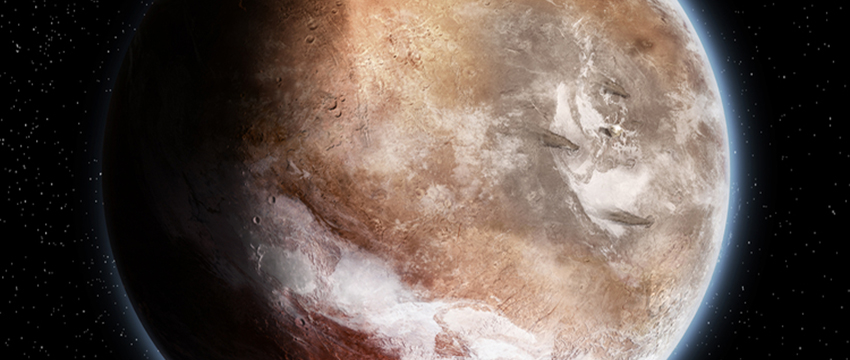
By Daniel Stolte, University Relations - Communications, March 4, 2016
Deep below the surface of the withered, dead and barren world that today is Mars lies evidence of a much more tumultuous upbringing of the red planet than scientists had expected. New research by an international team of planetary scientists including Isamu Matsuyama of the University of Arizona's Lunar and Planetary Laboratory, published in Nature, solves some of the biggest puzzles surrounding Mars' mysterious infancy.
In the new study, Matsuyama and his collaborators present a fresh look at the red planet, providing an elegant and simple explanation of the geological features that had scientists vexed for a long time.
Between 3 billion and 3.5 billion years ago, when life made its first appearance on Earth in the form of single-celled bacteria, dramatic changes happened on our neighboring planet. One of them caused the entire planet to tip over, bringing regions that once were closer to the poles toward the equator.
Its cause? Giant eruptions that threw up the largest volcanoes in the solar system and formed a bulge known as the Tharsis region, home of Olympus Mons. Towering 16 miles above the Martian surface, Olympus Mons is tall enough to eclipse three Mount Everests stacked on top of one another.
When such a massive volcanic bulge forms in one area, it throws the entire planet out of kilter, according to Matsuyama, an assistant professor in the UA's Department of Planetary Sciences who first presented evidence for the "great Martian tilt" in 2010 using gravity observations.
"Any major shift of planetary mass – on the surface or within the mantle – could cause a shift with respect to the spin axis, because a spinning body is most stable with its mass farthest from its spin axis," Matsuyama explains.
As more and more material accumulated in the bulge that became the Tharsis region, it caused Mars' spin axis to tilt by about 20 degrees. If the same happened to Earth, Tucson would come to lie at the position of present-day Calgary, Alberta. In the case of Mars, the volcanic bulge ended up at the equator, where it still remains today, long after its volcanoes have fallen dormant.
"The great tilt upsets our picture of the surface of Mars as it must have been 4 billion years ago," according to the authors, "and profoundly modifies the timing of events that gave Mars the face we know today."
For one, the team, led by Sylvain Bouley of the Université Paris-Sud in France, shows that zones of valley networks - carved into the Martian surface during a time when water flowed vigorously and plentiful - are consistent with the reorientation of Mars due to the formation of the Tharsis volcanic region.
"The present distribution of valley network contains large variations in longitude that are difficult to explain without the tilting scenario," Matsuyama says, "because with the current orientation of Mars relative to its spin axis, you see evidence of precipitation where you should not see it. The extensive networks of valleys and channels change latitude as you move in longitude."
Using data from detailed gravity and topography measurements taken by spacecraft orbiting Mars, the team reconstructed what a young Mars would have looked like, before its face changed and aged so dramatically.
"In our models we got rid of the Tharsis regions, and we reoriented the planet to its original geometry before the tilt," Matsuyama says. And when the researchers then ran climate simulations, they saw the precipitation that carved the valley networks occur in the locations where they should be – in a more or less symmetrical ring just south of Mars' equator before the tilt.
A second feature of Martian topography that had scientists scratching their heads also neatly falls into place with the new calculations: Until now, it was thought that the bulk of the Tharsis region had formed much earlier than the valley networks, about 3.7 billion to 4.1 billion years ago, determining the orientation of their riverbeds and canyons. But the new calculations of a Mars without the Tharsis bulge showed that is not the case.
The authors conclude that the tropical precipitation that created the valleys likely occurred at the same time and independently of the formation of the Tharsis region. This would elegantly explain where all that water might have come from that was necessary to form the vast networks of valleys, because a major source for Mars is water vapor injected into the atmosphere by volcanoes.

